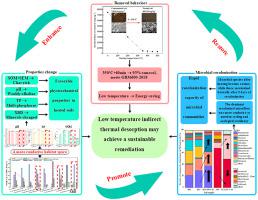当前位置:
X-MOL 学术
›
Environ. Pollut.
›
论文详情
Our official English website, www.x-mol.net, welcomes your feedback! (Note: you will need to create a separate account there.)
Sustainable remediation of lube oil-contaminated soil by low temperature indirect thermal desorption: Removal behaviors of contaminants, physicochemical properties change and microbial community recolonization in soils
Environmental Pollution ( IF 8.9 ) Pub Date : 2021-06-15 , DOI: 10.1016/j.envpol.2021.117599 Yimin Sang 1 , Wang Yu 1 , Liao He 1 , Zhefeng Wang 1 , Fujun Ma 2 , Wentao Jiao 3 , Qingbao Gu 2
Environmental Pollution ( IF 8.9 ) Pub Date : 2021-06-15 , DOI: 10.1016/j.envpol.2021.117599 Yimin Sang 1 , Wang Yu 1 , Liao He 1 , Zhefeng Wang 1 , Fujun Ma 2 , Wentao Jiao 3 , Qingbao Gu 2
Affiliation

|
Thermal desorption is widely adopted for the remediation of organic compounds, yet is generally considered a non-green-sustainable manner owing to its energy-intensive nature and potential to deteriorate soil reuse. Here, lube oil-contaminated soils were remediated at 200–500 °C in nitrogen atmosphere, upon which removal behaviors of lube oil and physicochemical properties of soils were explored. Illumina 16S ribosomal RNA (rRNA) and 18S rRNA amplicon sequencing were employed to determine the relative abundances and diversities of bacteria and fungi in soils, respectively. The results indicated that, after heating at 350 °C for 60 min, 93% of the lube oil was reduced, with the residual lube oil concentration lower than the Chinese risk intervention values (GB 36600–2018). The weakly-alkaline, multi-phosphorus and char-rich soils after indirect thermal desorption could provide a nutrient source and favorable habitat space for living organisms, and the decomposition of minerals in soils is more conducive to the survival of organisms. Microbial species in soils after heating at 350 °C became extinct, however, microbial species after 3 days of recolonization were enough to carry out DNA extraction when these soils were exposed to natural grass land. Though the microbial richness and diversity in heated soils after 3 days of recolonization were still little lower than those in contaminated soils, (29.41%) and (9.33%) became dominant at phyla level, while (16.37%), (10.09%), (7.91%) and (6.84%) were dominant at general level, whose ecological function was more conducive to nutrient cycling and ecological resiliency. Overall, this innovative research provides a new perspective: low temperature indirect thermal desorption may also achieve a sustainable remediation, due to its energy-saving (low temperature), favorable physicochemical properties and the rapid recolonization capacity of microbial communities in heated soils.
更新日期:2021-06-15

























 京公网安备 11010802027423号
京公网安备 11010802027423号